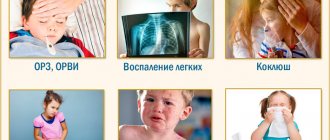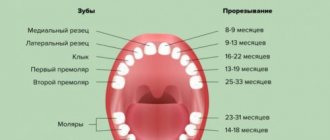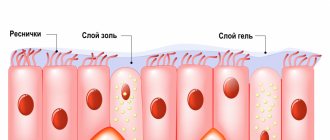Causes of cough in children
Coughing is a protective reaction to irritation of the mucous membrane of the respiratory tract.
Thanks to coughing, the airways are cleared of secretions that are formed during inflammation of the bronchi, as well as when any irritants enter: allergens, viruses, bacteria. The main causes of cough in children:
- Infectious and inflammatory processes in the upper parts of the respiratory system (ARVI, tonsillitis, laryngitis, sinusitis, pharyngitis).
- Infectious and inflammatory processes in the lower parts of the respiratory system (tracheitis, bronchitis, pneumonia).
- Allergic diseases, bronchial asthma.
- Drying of the mucous membranes due to dry air in the room.
- Entry of a foreign body.
- Drainage of nasal mucus down the back of the throat and towards the larynx. Occurs when lying on your back.
- The release of gastric juice from the esophagus (gastroesophageal reflux).
- Whooping cough.
- Heart failure.
- Neurotic disorder.
Dry cough in a child
A dry cough usually occurs against the background of a respiratory disease and is localized in the upper part of the respiratory tract. With this type of cough, no sputum is produced.
At the beginning of an acute respiratory infection (ARI), the cough is dry, debilitating, and the general condition of the body worsens. At this stage, complete cleansing of the respiratory tract does not occur, but after a few days, sputum gradually begins to be released from the bronchi.
However, this does not always happen. In some cases, a dry cough can last up to 3 weeks or more. The likely cause of this cough is inflammation . A reflex urge to cough leads to an intensification and spread of the inflammatory process of the throat or larynx.
A prolonged dry cough that lasts for weeks without any fever or weakness is most often a sign of an allergic reaction to animal hair, dust, or tobacco smoke.
Wet cough in a child
Cough with sputum is characteristic of a number of serious diseases: from acute respiratory viral infections to pneumonia and tuberculosis. Foreign particles, toxins, and bacteria are removed from the respiratory tract with sputum. It is important to pay attention to the color and consistency of the mucus coming out:
- white thick is characteristic of ARVI;
- clear mucus is characteristic of bronchial asthma, allergic reactions, heart diseases;
- yellow mucus occurs during purulent processes;
- a rusty color indicates damage to small capillaries in the lungs, which is typical for pneumonia;
- a greenish tint indicates pneumonia, purulent bronchitis;
- brown color is characteristic of tuberculosis and lung tumors.
Of course, it is impossible to make a diagnosis based solely on the type of sputum. Competent consultation with a specialist (pediatrician, pulmonologist, otolaryngologist) and tests are always necessary.
Cough and fever
An increase in temperature when coughing indicates a reaction of the immune system to the occurrence of an inflammatory process in the body.
Dry cough with fever
The most common causes of a dry cough with an elevated temperature in the range of 37–37.5 0C are infectious and inflammatory diseases in the initial stage.
- Flu, ARVI . In the first days of the disease, the cough is irritating, painful, and dry.
- Laryngitis . With the development of inflammation of the larynx, the cough is convulsive, barking, and there is a feeling of obstruction in the throat when swallowing.
- Pharyngitis . Noticeable redness of the back of the throat with persistent cough and rapid rise in temperature.
- Dry pleurisy . Chest pain worsens with sharp inspiration or coughing.
- Pneumonia of atypical form . Inflammation of the lungs is accompanied by a dry cough, chills, the condition worsens sharply, and shortness of breath may occur.
- Whooping cough . Most often children of the first year of life and school age become ill. A paroxysmal cough at the beginning is unproductive; as the disease progresses, the attacks intensify and end with vomiting or spitting out thick, viscous sputum, followed by a characteristic wheezing inhalation.
- Bronchial asthma . Choking and loud wheezing may occur. Clearing the throat, inhaling and especially exhaling is difficult.
- Worm infestation . The appearance of a cough is associated with the entry of helminth larvae into the lungs. Breathing becomes whistling and audible at a distance.
Wet cough with fever
Typically, a cough becomes productive in the later stages of the same acute respiratory infections: viral and bacterial. It is often accompanied by fever - a high temperature of up to 38 0C. Cases requiring special attention:
- Bronchitis . May develop as a complication of acute respiratory infections. High temperature and cough with sputum indicate an active inflammatory process in the bronchi.
- Pneumonia is typical . A wet cough appears due to the proliferation of microorganisms, which provoke copious mucus secretion in the bronchi.
- Lung abscess . It is characterized by the formation of a hollow area in the lung tissue that is filled with pus. When the cavity ruptures, purulent sputum comes out, it has an unpleasant odor, and may contain blood impurities.
- Tuberculosis . The temperature is kept up to 38 and rarely up to 39 degrees. The cough is severe and blood may be released. The sputum of a patient with tuberculosis contains mycobacteria and is infectious to others.
Cough without fever
The most common causes of cough at normal temperature in a child are:
- The onset of viral and bacterial infections while the immune response has not yet developed and the temperature has not risen.
- Allergic reaction to plant pollen, dust, mold, animal hair, etc.
- A reflex reaction to dust, smoke, and aerosols entering the bronchial mucosa.
- Entry of a foreign body into the respiratory tract.
- Diseases of the nasopharynx, impaired flow of mucus from the nose.
- After illnesses as a residual phenomenon.
Causes of cough
The nature of the cough may be as follows:
- inflammatory. Both the airways and alveoli can become inflamed. Diseases: laryngitis, pneumonia, lung abscess, tracheitis, bronchitis;
- irritable from mechanical influence. Increased bonus of the bronchi, their compression, bronchial asthma, fibrosis, pulmonary edema;
- irritable from chemical exposure. When harmful substances and gases enter the lungs and bronchi. For example, cigarette smoke, harmful aerosols, carbon monoxide;
- thermal impact. Too cold or very hot air can cause lung irritation.
Depending on the nature of the cough, it can be:
- wet – with sputum separation;
- dry - without discharge, usually due to lack of lubrication on the mucous membranes.
Each type of cough requires special, individual treatment. How often do we desperately run to the pharmacy and get lost in choosing the right medicine. In order to effectively cope with the disease and determine how to treat cough in each case, we will consider the main situations in which cough occurs and suggest the most effective remedies for treatment.
A child has a cough.
A real disaster for parents is when their child gets sick. First, find out whether the cause of the cough is a fairly common childhood cold. Temperature, nasal congestion, lethargy and chills are all indications that the baby has a cold. The cough may be strong or weak, but not barking or screaming. Usually frequent.
Cough in an adult.
What about adults? After all, they also suffer from various types of cough, and their range of these types is a little wider. Chronic coughing and constant sore throat are becoming increasingly common. Women during pregnancy should be careful with medications and be sure to ask their doctor which medications are strictly prohibited during this period.
Cough medicines for children
How to treat cough in children
First of all, treatment is carried out to combat the causative agent of the disease and to alleviate the general condition of the child.
- If the cough is caused by a bacterial infection, then antibacterial drugs are prescribed.
- For a viral cause of the disease, antiviral drugs are prescribed, for a fungal infection of the lungs, antifungal drugs are prescribed.
- The allergic form of the disease requires the use of antihistamines.
- If sputum is poorly separated from the bronchi, then the prescription of mucolytic drugs is required.
- If your body temperature is elevated (above 38 degrees), you need to take antipyretics.
Cough preparations by group
What cough remedies should not be used by children?
In childhood, the cough reflex is not complete; it is formed by 5-6 years. It is important for both pediatricians and parents to remember that the use of drugs that suppress the cough reflex is contraindicated, especially in young children. It is also necessary to limit the use of expectorants, as they increase the volume of mucus secreted, which can lead to stagnation and further reinfection.
What can you give children for cough?
Mucolytics are the most promising for the treatment of diseases of the upper and lower respiratory tract. They are used for non-productive or productive cough with sputum that is difficult to separate. Today, the following mucoactive drugs are widely used in pediatric practice: bromhexine, ambroxol and acetylcysteine (ACC).
The main methods of using medicines in children are oral and inhalation. Depending on the disease, age and preference of the child, the choice of form is considered individually.
Folk remedies for cough
In the early stages, colds can be treated with traditional medicine. To do this, you need to moisturize your throat and strengthen your immune system. Fruit drinks made from berries effectively cope with this task. The recipe for their preparation is simple.
- Squeeze the juice from the berries through cheesecloth.
- Make a sweet compote from the solid part.
- When it has cooled, add the juice (do not boil!).
Give your child a small cup of fruit drink every 15-20 minutes. The liquid will soften the mucous membrane, and the vitamins will strengthen the defenses and force the body to fight infection.
A wet cough can be cured with black radish juice. To do this, cut out the middle of the vegetable and fill it with honey. After 5-6 hours, an active release of viscous, sweet, slightly tart liquid occurs. Give it to your child 1 teaspoon every 2-3 hours.
Another way to treat residual wet cough is to drink warm milk-based drinks. To do this, add 1 teaspoon of honey, butter or soda to a glass of heated liquid. Any of these cocktails softens the walls of the nasopharynx and helps cough up mucus. At the same time, the product has a slight calming effect. Therefore, it is useful to give it to a 2-year-old child before bedtime.
- How to treat a dry cough in an adult that lasts for a long time without fever
Bromhexine for children
The drug bromhexine is actively used in pediatric practice and has various release forms suitable for children: syrup, mixture (solution), low-dose tablets (4 mg).
The effect of bromhexine is based on the drug’s ability to thin mucus and facilitate its removal from the child’s respiratory tract.
Cough syrup for children
syrup is very easy to use, has a fruity taste and children drink it with pleasure. The syrup is prescribed to children from two years of age. This is due to the fact that children under one year old cannot cough on their own and they may experience stagnation of sputum in the bronchi. The accumulation of sputum can lead to a deterioration in the child’s condition and a protracted course of the disease.
Can children take cough drops?
The administration of tablets with a pediatric dosage of 4 mg is permitted from 3 years of age. Bromhexine is also available in a drinking solution and drops, which contain medicinal plant oils. These forms are used only for children over 12 years of age, since the composition contains ethanol.
During treatment with bromhexine, the child should be given enough fluids. To improve the removal of mucus from the bronchi, it is useful to massage the chest, especially for young children. And be sure to consult a doctor before using the drug.
How can you eliminate a wet cough?
A severe wet cough in two-year-olds can be eliminated with drugs from the following list:
- Ambroxol.
- Joset.
- Gedelix.
Ambroxol
This remedy becomes equally effective for wet and dry coughs. A drug containing ambroxol hydrochloride is indicated for the following diseases:
- bronchitis;
- pneumonia;
- bronchial asthma;
- laryngitis;
- tracheitis.
During therapy with this remedy, spasms in the bronchi are quickly eliminated, inflammation is relieved, the airways are cleared of excess mucus, and the level of the body’s immune defense is increased.
At 2 years of age, patients are shown 1.25 ml of syrup at a time (1/4 measuring spoon). The medication is taken 2-3 times a day.
Joset
The composition of this product is represented by 3 main components - salbutamol, bromhexine and guaifenesin. The drug helps to more actively remove mucus, expand the airways, and eliminate spasms. Joset has a wide range of uses and is prescribed to patients with various forms of bronchitis, pneumonia, tracheobronchitis, and COPD.
The dosage of cough medicine for children 2 years old should be discussed with the doctor. Most often, children are prescribed 5 ml of syrup three times a day.
Gedelix
The presence of ivy extract in this preparation provides a pronounced expectorant and softening effect. Additional ingredients of the drug exhibit antispasmodic, mucolytic, anti-inflammatory and antibacterial properties.
After the patient reaches 2 years of age, syrup is prescribed three times a day, 2.5 ml per dose. Gedelix is best taken after meals, diluted with a small amount of warm boiled water.
Despite the effectiveness and mild action of such medications, any of them should be taken as prescribed by a pediatrician. Independent selection of the drug is not recommended, as it can lead to a deterioration in the condition of the small patient .











